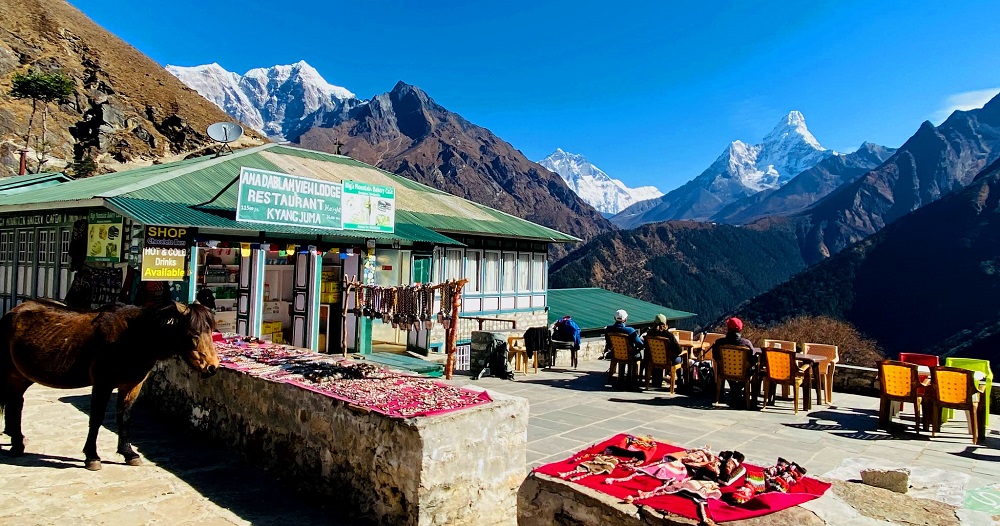All you need to know about Kyangjuma | Interesting things about Kyangjuma village
Kyangjuma is a small village located in the Khumbu region of Nepal, which is famous for being the gateway to Mount Everest. Here are some interesting things about Kyangjuma:
1. Scenic Location:
Kyangjuma is situated at an altitude of approximately 3,550 meters (11,646 feet) above sea level. It lies on the trail that leads from Namche Bazaar (the main town in the Khumbu region) to Tengboche Monastery. Kyangjuma is situated in a picturesque setting, surrounded by awe-inspiring mountains and verdant valleys. The village offers stunning views of some of the most iconic peaks in the world, including Ama Dablam, one of the most beautiful mountains in the Himalayas. Its pyramid-like shape and snow-covered slopes make it a sight to behold. Thamserku, another prominent peak visible from Kyangjuma, stands tall and imposing, creating a dramatic backdrop for the village. Kangtega, with its twin summits, adds to the grandeur of the landscape.
2. Trekking Hub:
As a crucial stop on the trekking route to Everest Base Camp, Kyangjuma provides a vital rest and acclimatization point for trekkers. The village is strategically located at an elevation that allows hikers to adjust to the increasing altitude. From Kyangjuma, trekkers can continue their journey to famous destinations like Everest Base Camp, Gokyo Lakes, Island Peak, and Ama Dablam Base Camp. Proper acclimatization is essential to avoid altitude sickness and ensure a safe and enjoyable trekking experience. Kyangjuma offers a serene environment and comfortable accommodations, making it an ideal spot to rejuvenate before continuing the journey.
3. Stunning Mountain Views:
Kyangjuma offers breathtaking views of some of the world's highest peaks, including Mount Everest (8,848 meters/29,029 feet), Lhotse (8,516 meters/27,940 feet), Nuptse (7,861 meters/25,791 feet), Ama Dablam (6,812 meters/22,349 feet), and Thamserku (6,623 meters/21,729 feet). The village provides a fantastic vantage point for trekkers and mountaineers to appreciate the surrounding Himalayan scenery.
4. Sherpa Culture:
The Sherpas, an ethnic group native to the region, have a deep connection to the mountains and a rich cultural heritage. Kyangjuma provides an opportunity to immerse oneself in Sherpa culture. Visitors can interact with the friendly locals, experience their warm hospitality, and learn about their unique way of life. Sherpa cuisine, characterized by hearty dishes like dal bhat (lentil soup with rice), momo (dumplings), and yak-based dishes, is often available in the tea houses and lodges. You might also get a chance to witness traditional ceremonies, such as Mani Rimdu, a vibrant Buddhist festival celebrated in the region.
5. Tea Houses and Lodges:
Kyangjuma has a few tea houses and lodges that cater to trekkers' needs. These establishments provide comfortable accommodations, typically consisting of simple rooms with beds and shared bathrooms. Most tea houses also have dining areas where trekkers can enjoy hearty meals and warm beverages. The cozy atmosphere, often accompanied by a fireplace, creates a welcoming ambiance, perfect for relaxing after a day of trekking. Interacting with fellow trekkers from different parts of the world fosters a sense of camaraderie and offers an opportunity to share trekking experiences and tips.
6. Gokyo Lake Access:
Kyangjuma serves as a starting point for trekkers who wish to explore the stunning Gokyo Valley and its famed lakes. The journey from Kyangjuma to Gokyo Lake takes you through diverse landscapes, including dense forests, terraced fields, and rocky moraines. Along the way, you'll pass through charming Sherpa villages like Mong La and Dole, where you can observe the local way of life. As you ascend, the mesmerizing Gokyo Lakes come into view. These six high-altitude lakes, including the pristine Gokyo Lake, offer a breathtaking sight with their turquoise waters set against the backdrop of majestic peaks.
7. Rich Biodiversity:
Kyangjuma falls within the boundaries of Sagarmatha National Park, home to a remarkable array of flora and fauna. The park is renowned for its rhododendron forests, which bloom in vibrant colors during the spring season. Other plant species found in the region include birch, juniper, and blue pines. The park is also a habitat for various wildlife, including the elusive snow leopard, musk deer, Himalayan thars (wild goats), and numerous bird species. Exploring the trails around Kyangjuma offers opportunities to spot these fascinating creatures and immerse oneself in the region's biodiversity.
In summary, Kyangjuma in the Khumbu region offers a perfect blend of natural beauty, Sherpa culture, trekking infrastructure, and biodiversity. It is an ideal base for trekkers embarking on the journey to Everest Base Camp or exploring the enchanting Gokyo Valley. The village's scenic location, warm Sherpa hospitality, and close proximity to iconic mountains and serene lakes make it a must-visit destination for adventure seekers and nature enthusiasts.




.jpg)



